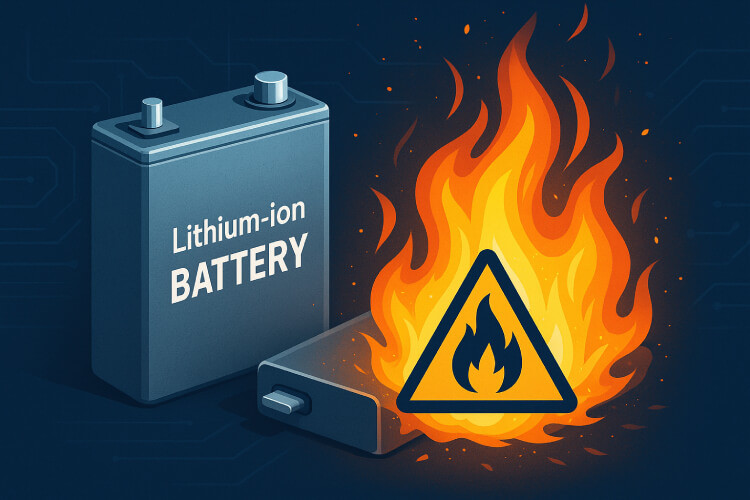Lithium-Ion Battery Sensor Detects Early Vapour Leaks
Insights | 15-05-2025 | By Robin Mitchell

As lithium-ion batteries continue to dominate the energy storage landscape—from smartphones to electric vehicles and large-scale grid systems—their benefits are matched by mounting safety concerns. High energy density, while crucial for performance, brings with it an increased risk of overheating, fires, and even explosions. Despite efforts to mitigate these dangers, high-profile incidents have underscored the urgent need for smarter, more proactive safety solutions.
Key Takeaways:
- Sensor innovation for lithium-ion batteries: Researchers have developed a sensor capable of detecting ethylene carbonate vapours released during early-stage overheating, providing critical pre-emptive safety data.
- Improved battery safety management: The sensor offers greater selectivity and sensitivity than current thermal monitoring, potentially reducing fire risks in electric vehicles and grid storage systems.
- Scalable integration with battery systems: Designed to work with existing battery management systems, the sensor supports real-time gas monitoring and aligns with evolving international safety standards.
- Foundation for future chemistries: The modular chemical structure of the sensor's covalent organic polymer allows for adaptation to other battery types, including solid-state and lithium-sulphur technologies.
What makes lithium-ion batteries so hazardous, and how can we make them safer? In this article, we explore the inherent risks of this widely used technology and examine a promising new sensor developed to detect early signs of battery failure, offering a potential breakthrough in battery safety management.
The Perils of Power: Unpacking the Safety Challenges of Lithium-Ion Battery Technology
The evolution of lithium-ion batteries has been nothing short of remarkable. From their humble beginnings in the 1980s to their widespread adoption in portable electronics, electric vehicles, and renewable energy storage systems, these batteries have revolutionised the way we consume energy. However, as their popularity has grown, so has the recognition of their safety risks. In this article, we will delve into the challenges posed by lithium-ion batteries, from their high energy density to their potential for catastrophic failures.
The story of lithium-ion batteries is a complex one, marked by both excitement and caution from the outset. When they were first developed, researchers were acutely aware of their safety concerns. The high energy density of lithium ions, which enables them to store large amounts of energy in a small space, also makes them prone to thermal runaway. This phenomenon occurs when a battery is subjected to excessive heat, causing a chain reaction that can lead to fires or even explosions. Despite these warnings, the allure of lithium-ion batteries proved too great, and they rapidly gained traction in the industry.
Electric Vehicles and the Escalating Challenge of Battery Fire Safety
Fast forward to the present, and the safety risks associated with these batteries have become a major concern. The widespread adoption of electric vehicles (EVs) has led to a surge in the number of lithium-ion batteries on the road. While EVs offer a promising solution to reducing greenhouse gas emissions, the risk of battery fires poses a significant threat to public safety. In the event of an accident, the high-energy density of lithium-ion batteries can make them difficult to extinguish, leading to devastating consequences. In fact, some studies have shown that EV fires are twice as difficult to put out as those involving gasoline-powered vehicles.
The challenges posed by lithium-ion battery safety are not limited to EVs. Large-scale energy storage systems, such as those used in grid storage, also face significant safety risks. While these batteries offer a promising solution for stabilising the grid and integrating renewable energy sources, the high cost of potential failures can make them economically unviable. The economic implications of safety concerns are particularly relevant in large-scale applications, where the cost of a single failure can be staggering. In such cases, the cost of safety measures and precautions can outweigh the benefits of using lithium-ion batteries, making alternative technologies more attractive.
Sensor Developed to Detect Overheating in Lithium-Ion Batteries
Researchers from Xi'an Jiaotung-Liverpool University (China) and the University of Liverpool (UK) have developed a new sensor that can detect trace amounts of volatile vapours released by overheating lithium-ion batteries. The sensor, which is highly sensitive and cost-effective, has the potential to be integrated into existing battery management systems to prevent catastrophic failures and enhance the overall reliability of lithium ion-powered technologies.
Early detection of electrolyte vapour emissions, particularly ethylene carbonate, has become increasingly vital in electric vehicle battery systems. Automotive manufacturers are actively seeking embedded diagnostics to meet growing regulatory and insurance expectations around battery safety. According to market analysis from IDTechEx, advanced battery management systems integrating real-time gas monitoring could see widespread adoption across next-generation EV platforms, especially in Europe and Asia.
Simulation-Guided Sensing Targets Ethylene Carbonate Emissions
The sensor, which is described in a paper recently published in the journal ACS, is designed to detect ethylene carbonate (EC), a key component of a lithium-ion battery's electrolyte. According to the researchers, the sensor is the first to be guided by computer simulations to selectively detect EC vapour, making it highly sensitive and selective. The sensor can detect EC vapours at concentrations as low as one part per million in laboratory tests, indicating that it has the potential to detect potential failures long before they become hazardous.
Such sensitivity aligns with the growing demand for pre-emptive safety solutions in densely populated urban transport systems. Instances of battery thermal events on public transport have prompted policy shifts towards condition-based monitoring. While current-generation sensors in EVs primarily rely on temperature thresholds, vapour detection presents a more proactive and predictive layer of safety.
Covalent Organic Polymers: A Targeted Approach to Vapour Detection
The sensor was developed using molecular frameworks called covalent organic polymers (COPs), which are known for their ability to selectively detect different gas vapours. The researchers screened hundreds of potential materials before identifying a specific COP called COF-QA-3 as the best candidate. The sensor has been tested in laboratory conditions and has shown promising results, demonstrating its ability to detect leaks long before they cause any damage.
By leveraging COPs like COF-QA-3, the sensor benefits from a modular chemical architecture, which may be customised for other electrolyte compounds in future chemistries. This flexibility could support adaptation to solid-state or lithium-sulphur batteries, where unique failure signatures demand tailored sensing strategies. The researchers indicated this modularity as a pathway to developing a broader safety ecosystem across battery types.
Real-World Integration and the Drive for Safer Battery Systems
The researchers hope that their sensor will be integrated into existing battery systems to provide an early warning system for potential failures. According to the researchers' data, there were at least 20 reported fires or explosions of lithium-ion batteries in electric vehicles worldwide between 2021 and 2022. While such incidents are rare, they can have devastating consequences, and the researchers believe that their sensor could help prevent such incidents in the future.
Though the technology remains at the experimental validation stage, industry stakeholders have begun examining how such sensors could be scaled and ruggedised for commercial deployment. Discussions around ISO 6469-1 and UN ECE R100 standards increasingly reference embedded diagnostics, positioning this innovation as timely and potentially standard-defining in lithium-ion safety advancements.
Pioneering Tomorrows Power – Embracing Sensored Advances
If the developed sensor can be integrated into lithium-ion batteries, then the resulting implications are numerous. For example, real-time data analytics can help identify potential issues before they become major problems, reducing the risk of catastrophic failures and improving overall system performance.
The use of such sensors also allows engineers to explore new designs and materials that would otherwise be deemed too risky to use, as catastrophic incidents can be stopped before they manifest. This would in turn result in much higher energy densities, faster charging times, and a continuation in the size reduction of modern electronics.
As we look towards the future of lithium-ion technology, it is clear that the challenges presented by the high energy density of these battery technologies will need to be addressed. The development of the new sensor is a significant step in this direction, and it is likely that the use of such technologies will become widespread in the coming years. But as we move forward, it is essential that we do so in a way that balances the benefits of lithium-ion technology with the need to protect the environment and ensure public safety.

